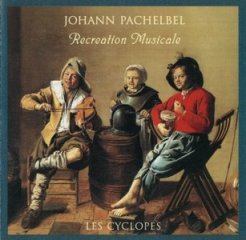Johann Pachelbel – Recreation Musicale (1995)
Johann Pachelbel – Recreation Musicale (1995)

Partie VI B Flat Major
1. Sonata Adagio
2. Aria
3. Courant
4. Gavotte-Variatio
5. Saraband play
6. Gigue
Partie III E Flat Major
7. Sonata Allegro
8. Allemand
9. Courant
10. Gavotte
11. Saraband
12. Gigue
Partie IV E Minor
13. Sonata Adagio
14. Aria
15. Courant
16. Aria
17. Ciacona
Partie I F Major
18. Sonata Allegro
19. Allemand
20. Courant
21. Ballet-Variatio
22. Saraband
23. Gigue
Partie II C Minor
24. Sonata
25. Gavotte-Variatio
26. Trezza
27. Aria
28. Saraband
29. Gigue
Partie V C Major
30. Sonata
31. Aria play
32. Trezza
33. Ciacona
Les Cyclopes
Laura Johnson, violin
Manfredo Kraemer, violin
Nina Diehl, cello
Thierry Maeder, positive organ
Bibiane Lapointe, harpsichord
Johann Pachelbel (baptized September 1, 1653 – buried March 9, 1706) was a German Baroque composer, organist and teacher, who brought the south German organ tradition to its peak. He composed a large body of sacred and secular music, and his contributions to the development of the chorale prelude and fugue have earned him a place among the most important composers of the middle Baroque era.
Pachelbel's music enjoyed enormous popularity during his lifetime; he had many pupils and his music became a model for the composers of south and central Germany. Today, Pachelbel is best known for the Canon in D, the only canon he wrote - although a true canon at the unison in three parts, it is often regarded more as a passacaglia, and it is in this mode that it has been arranged and transcribed for many different media. In addition to the canon, his most well-known works include the Chaconne in F minor, the Toccata in E minor for organ, and the Hexachordum Apollinis, a set of keyboard variations.
Pachelbel's music was influenced by southern German composers, such as Johann Jakob Froberger and Johann Kaspar Kerll, Italians such as Girolamo Frescobaldi and Alessandro Poglietti, French composers, and the composers of the Nuremberg tradition. He preferred a lucid, uncomplicated contrapuntal style that emphasized melodic and harmonic clarity. His music is less virtuosic and less adventurous harmonically than that of Dieterich Buxtehude, although, like Buxtehude, Pachelbel experimented with different ensembles and instrumental combinations in his chamber music and, most importantly, his vocal music, much of which features exceptionally rich instrumentation. Pachelbel explored many variation forms and associated techniques, which manifest themselves in various diverse pieces, from sacred concertos to harpsichord suites.
download: uploaded yandex 4shared mediafire solidfiles mega filecloudio nornar ziddu
Zmieniony (Piątek, 07 Marzec 2014 09:43)








